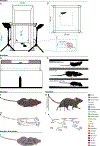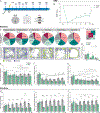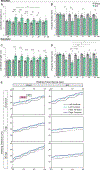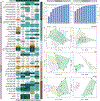A deep learning-based approach for unbiased kinematic analysis in CNS injury
- PMID: 39242068
- PMCID: PMC12576851
- DOI: 10.1016/j.expneurol.2024.114944
A deep learning-based approach for unbiased kinematic analysis in CNS injury
Abstract
Traumatic spinal cord injury (SCI) is a devastating condition that impacts over 300,000 individuals in the US alone. Depending on the severity of the injury, SCI can lead to varying degrees of sensorimotor deficits and paralysis. Despite advances in our understanding of the underlying pathological mechanisms of SCI and the identification of promising molecular targets for repair and functional restoration, few therapies have made it into clinical use. To improve the success rate of clinical translation, more robust, sensitive, and reproducible means of functional assessment are required. The gold standards for the evaluation of locomotion in rodents with SCI are the Basso Beattie Bresnahan (BBB) scale and Basso Mouse Scale (BMS). To overcome the shortcomings of current methods, we developed two separate markerless kinematic analysis paradigms in mice, MotorBox and MotoRater, based on deep-learning algorithms generated with the DeepLabCut open-source toolbox. The MotorBox system uses an originally designed, custom-made chamber, and the MotoRater system was implemented on a commercially available MotoRater device. We validated the MotorBox and MotoRater systems by comparing them with the traditional BMS test and extracted metrics of movement and gait that can provide an accurate and sensitive representation of mouse locomotor function post-injury, while eliminating investigator bias and variability. The integration of MotorBox and/or MotoRater assessments with BMS scoring will provide a much wider range of information on specific aspects of locomotion, ensuring the accuracy, rigor, and reproducibility of behavioral outcomes after SCI.
Keywords: DeepLabCut; Kinematics; Machine learning; Spinal cord injury; Traumatic brain injury.
Copyright © 2024. Published by Elsevier Inc.
Conflict of interest statement
Declaration of competing interest The authors declare no conflicts of interest. The funders had no role in the design of the study in the collection, analyses, or interpretation of data; in the writing of the manuscript, or in the decision to publish the results.
Figures







Update of
-
A deep learning-based approach for unbiased kinematic analysis in CNS injury.bioRxiv [Preprint]. 2024 Apr 12:2024.04.08.588606. doi: 10.1101/2024.04.08.588606. bioRxiv. 2024. Update in: Exp Neurol. 2024 Nov;381:114944. doi: 10.1016/j.expneurol.2024.114944. PMID: 38645091 Free PMC article. Updated. Preprint.
References
-
- Adams MM, and Hicks AL. 2005. Spasticity after spinal cord injury. Spinal Cord 43:577–586. - PubMed
-
- Ahuja CS, Wilson JR, Nori S, Kotter MRN, Druschel C, Curt A, and Fehlings MG. 2017. Traumatic spinal cord injury. Nat Rev Dis Primers 3:17018. - PubMed
-
- All AH, and Al-Nashash H. 2021. Comparative analysis of functional assessment for contusion and transection models of spinal cord injury. Spinal Cord 59:1206–1209. - PubMed
-
- All AH, Al Nashash H, Mir H, Luo S, and Liu X. 2020. Characterization of transection spinal cord injuries by monitoring somatosensory evoked potentials and motor behavior. Brain Res Bull 156:150–163. - PubMed
MeSH terms
Grants and funding
LinkOut - more resources
Full Text Sources
Medical

